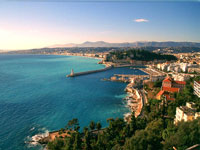 Nice OverviewWith an international airport and the fast train from Paris,
Nice is the first experience of the renowned Côte d'Azur for many
tourists. The city was established by the Greeks and named for
Nike, goddess of victory, but the Romans started the tourism
industry here when they popularised their mineral baths on Cimiez.
British and Russian aristocrats favoured Nice in the 19th century,
but today it is more of a commercial centre and is not as
fashionable as its smaller neighbouring resorts, such as Cannes or
St Tropez. Nice still has excellent connections, but these are in
the mode of transport options rather than the pedigree of its
visitors. In spite of modernization, the city retains its medieval
heritage in the atmospheric Vieille Ville (old town), with its
closely packed red-tiled roofs and narrow winding streets packed
with shops, bars and fabulous restaurants. Next door, the famous
Cours Saleya flower and food market has scores of stands, from
large, professionally displayed wares to folding tables set up by
family farmers with their produce directly from the farm. Separating the Cours Saleya from the sea is a strip of low
buildings. Once the repository for the fishermen's catch, they have
given way largely to popular seafood restaurants, while the other
side of the Cours Saleya is lined by terrace cafés in lovely old
buildings. Nice's shingle beaches occasionally disappoint visitors
anticipating a classic, white sand beach holiday, but this does not
mean the beaches stay empty; during summer the bright blue sea,
sunshine and beautiful surroundings draw thousands of holidaymakers
to this French Riviera city. The Promenade des Anglais lines the
shingle beaches for about five miles (8 km) and has been a
favourite for leisurely strollers since Victorian times. |